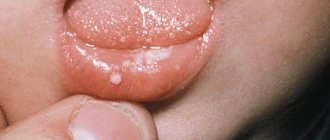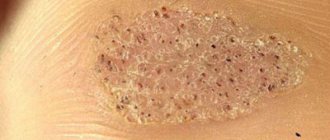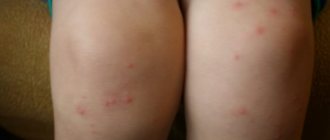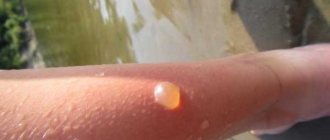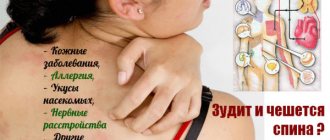Rash is a common occurrence in the lives of children. Watery blisters on the skin of a child can be a symptom of both infectious diseases occurring with exanthemas (chicken pox, herpes), and a non-infectious phenomenon associated with an allergic reaction or dermatitis.
In medicine, watery blisters on the skin are called vesicles and are cavity formations protruding above the surface of the skin and filled with transparent contents . Depending on the location, they are divided into intradermal, if located deep in the dermis, or subepidermal, when located superficially under the epidermis.
The mechanism of the appearance of vesicles under the influence of external and internal factors is the stratification of the skin layers, rupture of intercellular bridges and local accumulation of exudate in these spaces.
Primary contact dermatitis
Occurs as a result of direct contact of the skin with an irritant.
Types of damaging factors:
- Physical. Exposure to radiation, high or low temperature. In second-degree burns or frostbite, watery blisters appear on the surface of the skin. With a sunburn, blisters and detachment of the epidermis are observed.
- Mechanical, when pathological changes occur due to friction when wearing tight clothes or shoes (calluses on the feet).
- Biological, in which the damaging agent is either an insect bite (mite) or the action of a plant (nettle).
- Chemical - when the skin comes into contact with various substances that contain alkalis or high concentration acids that can destroy cell membranes and cause a burn.
Diaper rash (diaper dermatitis) occurs with prolonged exposure to urine and feces on the skin of the groin area and buttocks. Redness and a rash in the form of blisters and nodules appear. The child's general condition suffers slightly.
Causes of groin rash
You should not wait until the situation resolves itself, this will never happen, it is necessary to seek qualified help as quickly as possible. Only in this way will you be able to return to your normal life and be confident in good health.
Problems in the groin skin begin when sebum, under the influence of negative factors, such as alcoholism, smoking, abuse of spicy foods and coffee, becomes too thick, and the cells in the sebaceous gland thicken. Then the gland itself becomes clogged and a pimple forms. Acne in such a delicate area as the groin does not appear on its own, there are reasons for this. Common causes of acne include:
- lack of hygiene in the groin area;
- venereal diseases;
- hormonal disorders;
- fungal infections;
- poor nutrition - excessive indulgence in sweets;
- diabetes mellitus and other systemic diseases;
- skin hypersensitivity;
- lack of vitamins;
- allergic reactions;
- mechanical damage and skin trauma.
Skin inflammation can be caused by underwear that is too tight; it creates a greenhouse effect and leads to additional friction on the skin. At the site where the laundry touches, irritation remains and papules may form. This type of rash does not require drug treatment; it is enough to change your underwear and treat the skin with an antiseptic to prevent a bacterial infection from developing.
Every modern woman takes care of her groin area and tries to remove hair accordingly. A rash in the bikini area can be caused by a blunt machine or epilator. Instead of cutting off the hairs, it begins to pull them out, injuring the skin, and creates excellent conditions for the proliferation of bacteria and fungus. If you want to avoid this situation, just change the blade in a timely manner. Another reason can be ingrown hairs; this happens due to rapid keratinization of the skin, which prevents hairs from growing normally. If you use exfoliating products, this will not happen and acne can be avoided.
READ ALSO: How to get rid of acne at home?
An allergic reaction is also one of the possible causes. Allergies can be triggered by hygiene products, synthetic underwear, sexual lubricants and contraceptives. It is not uncommon for topical medications to provoke a rash in the groin area. If such a rash appears, be sure to inform your doctor, he will change the medicine and adjust the therapy.
Sometimes, women believe that acne is caused by frequent use of cosmetics, this is not true. Perhaps, back in Soviet times, creams with a thick texture were produced that clogged the pores. Modern products have a good structure, are easily absorbed and allow the skin to breathe. Some products even have the inscription “non comedon”, which means that the cream does not clog pores and does not lead to the formation of pimples.
During pregnancy, women's sweat glands work intensively, so it is not uncommon for women to experience a rash in their groin area. Such formations do not require treatment - this is prickly heat, it will go away on its own if the woman maintains hygiene.
Allergic dermatitis
Occurs in children with increased sensitization, that is, sensitivity. It occurs in the form of a delayed allergic reaction. After the first contact with the allergen, at least two weeks pass. At this time, specific antibodies are formed. Various chemical allergens act as irritants, of which there are currently more than three thousand .
Clinically, this is expressed by the appearance of hyperemic spots, then, against their background, numerous blisters filled with serous fluid appear. When they are opened, wet areas remain in the form of erosions, which soon become covered with crusts.
The main area of the rash is located at the site of direct contact with the allergen, but a secondary rash can appear on any part of the skin. Symptom descriptions include pain, burning, severe itching.
Signs of allergic dermatitis:
- After contact with an irritating substance, time must pass for the appearance of a rash.
- The intensity and prevalence of skin manifestations are not directly related to the concentration of the irritant and the time of its exposure.
- Specificity - the appearance of a rash only when exposed to a specific substance.
- Allergic dermatitis occurs without general toxic signs: without fever and deterioration in the general condition of the child.
Associated symptoms
Almost always, a rash in a child’s groin area is accompanied by unpleasant and even painful symptoms: fever, tearfulness, and lack of appetite. The biggest discomfort for a baby is itching.
Itching in boys
In a boy, redness and rashes often affect the groin and scrotum area. After washing, the itching subsides a little, gaining strength at night (which prevents the baby from getting enough sleep). The surface of the rash peels off. In this case, the skin of the penis is not affected by itching, but the perineum and intergluteal fold can be very itchy. Often this dermatological problem affects obese children due to the large area of skin folds in the groin area.
Toxicoderma
Toxicoderma is an acute lesion that developed under the influence of toxins that penetrated the skin through the hematogenous route. Unlike allergic dermatitis, the damaging factor does not act directly on the epidermis, but through the blood containing the allergen.
- In the first place in the frequency of development of toxicoderma are medications: antibiotics, sulfonamides, sleeping pills, tranquilizers, B vitamins and many others.
- In second place are skin lesions caused by food products.
- Various chemicals used in everyday life: gels, shampoos, washing powders, house cleaning products.
- Endogenous toxins are also produced in the body itself as a result of metabolic disorders, the functioning of the digestive system, liver, and kidneys.
One of the forms of toxicoderma is the vesicular type, in which widespread rashes form on the skin in the form of bubbles with liquid, surrounded by a ring of hyperemic skin. A variant of localized toxicoderma is dyshidrosis, when the rash is located on the soles and palms. With massive damage to large areas, the general condition worsens: against a background of weakness, the temperature rises, itching, chills, and pain occur.
Preventive measures
To avoid the appearance of unpleasant acne, you should follow some recommendations. Accidental sexual intercourse often leads to diseases of the skin and other organs, so it is necessary to use protective equipment or one partner. One of the reasons for the formation of blisters is lack of hygiene. You should take a shower at least once a day, especially for men with dirty jobs. Strengthening the body's protective functions will help prevent rashes. These include regular physical activity, proper nutrition, proper rest, and fresh air. If these rules are followed, the virus will not be able to reproduce.
Bacterial infection
If a child is infected with streptococcus on the body, blisters with liquid may appear on the skin, which can be seen in the photo below. The pathogen penetrates the surface layer of the epidermis through the slightest damage to the skin (insect bite, scratch).
First, bright red spots appear, after a day they are covered with bubbles with a cloudy liquid. As the pathological process progresses, the vesicles burst and the purulent contents flow out. When dry, hard yellow crusts form. The child is bothered by itching and burning. The disease is called streptococcal impetigo.
If the causative agent is staphylococcus, then it penetrates the skin through the mouths of the hair follicles. The contents of the blisters immediately become purulent.
Children from the neonatal period to 2 years get sick. The rash is localized on the extremities, rarely spreading to the trunk and face. In newborns, vesiculopustulosis is observed - single or multiple blisters with purulent watery contents. The predominant localization is the inner surface of the limbs, natural folds of the body, and torso.
A more severe type of rash is pemphigus - neonatal pemphigus. Flaccid blisters of various sizes appear on the child’s skin (on the chest, abdomen, on the flexor surfaces of the limbs). The bubbles quickly open, the liquid contents dry out, forming a crust. The process is superficial: the deeper layers of the skin are not affected. The causative agents are coccal microbes, Escherichia coli and Pseudomonas aeruginosa, Klebsiella, Enterobacter .
Video about the causes of red pimples on the face of newborns
Red pimples on the face of a newborn of a non-infectious nature do not require drug therapy and go away on their own after the cause is eliminated. But if, due to improper treatment of the rash, infection has occurred, then drug therapy is required.
The cleanliness of a child's skin, especially in the first months of life, depends on compliance with hygiene measures and the correct selection and use of children's cosmetics (powder, creams for diaper rash and dryness).
When applying a large layer of cream/powder to the skin or using it frequently, the sebaceous or sweat glands may become clogged, which can lead to the formation of a rash. With rare water procedures, pores also become clogged. Too frequent bathing can increase the dryness of the epidermis with the subsequent appearance of a rash.
When a woman in labor is discharged from the maternity hospital, the pediatrician discusses the rules for caring for the newborn’s skin. A pediatric nurse also monitors the baby’s condition daily for a month. If an infection is suspected, a pediatrician has the right to refer the child to the hospital for examination.
Allergy
An allergic reaction in the form of pimples can be caused by:
- cosmetic products;
- consumption of allergenic food by the mother (with natural feeding);
- synthetic bedding on which the child sleeps;
- detergent used to clean bottle nipples or pacifiers. Not completely washed off composition causes red spots to appear near the mouth;
- washing powder. If the product is not completely rinsed from the fabric, the allergen has an irritating effect on the skin;
- formula or milk (with artificial feeding);
- dust or pollen from plants (including domestic ones);
- medicines;
- pets (cats, parrots, dogs). Allergies can be caused by pet fur/feathers and sweat.
We suggest you familiarize yourself with a painful pimple on the tongue: how to treat it
If there is a rash due to an allergic reaction, the newborn may be bothered by additional symptoms:
- increased irritability and crying (due to itching);
- redness near the eyes and nose;
- lacrimation and nasal discharge;
- dry and flaky skin;
- bad dream.
In severe forms, swelling of the larynx or internal organs is possible, which leads to a sharp deterioration in the health of the newborn. Antihistamines are required.
Before childbirth, the concentration of estrogens (female hormones, which ensure the normal birth process) increases in a woman’s body, which also enters the child’s body.
Excess hormones are accompanied by increased activity of the sebaceous glands, which leads to their blockage and the formation of acne. Within 2-4 months, the newborn’s hormonal levels stabilize, and the rashes disappear without leaving any traces.
A distinctive feature of the rashes is their localization on the face of newborns (in rare cases, on the neck and chest). Pimples are not prone to merging. There are no additional symptoms. No treatment required.
Dysbacteriosis
After birth, the newborn’s intestines are sterile, microflora is completely absent. The colonization of beneficial bacteria begins with the first breath and food intake. They ensure the normal functioning of the digestive tract. Until the microflora is stabilized, the newborn experiences abnormal bowel movements, colic (the child characterizes the symptom as increased crying) and rashes.
Also, the development of dysbacteriosis in infants is observed due to:
- treatment with antibiotics, hormonal or laxative medications;
- severe infectious diseases;
- poor nutrition of the mother (during breastfeeding) or poor quality formula;
- weakened immunity (observed in premature babies).
Dysbacteriosis can be caused by the presence of infection in the digestive tract. Additionally, there will be an elevated body temperature. Treatment is prescribed by a pediatrician.
During long walks in hot or cold weather, as well as when moving to a different climate zone, the body experiences stress. As a result, a malfunction of organs and systems may occur (dysbacteriosis, excessive activity of the sebaceous or sweat glands), as well as rashes on the body and face.
Additionally, cold symptoms may be present. The symptoms go away on their own, but sometimes medication may be required.
Prickly heat
Red pimples can be a symptom of heat rash. It develops in children whose parents wrap them excessively in warm diapers or clothes, as well as when they spend a long time in a stuffy and humid room.
As a result of increased sweating, irritation appears on the skin in the form of small red spots. There are no additional symptoms; when the temperature normalizes, the rashes stop.
If parents continue to wrap the baby further, the skin becomes inflamed. The formation of crusts with the addition of infection is possible. In this case, drug treatment will be required.
When baby teeth erupt, the production of saliva increases. With regular contact with the skin, it has an irritating effect, causing the development of rashes around the oral cavity. After tooth eruption is complete, saliva production returns to normal and pimples go away on their own.
Also, increased salivation can be caused by the child’s inability to swallow saliva in a timely manner (acceptable up to 2 years), the presence of pathologies in the oral cavity, or diseases of the gastrointestinal tract. In this case, additional signs are present (except for drooling). Drug therapy is required.
Diaper dermatitis
Diaper dermatitis develops in infants due to prolonged contact with urine or feces. They irritate the newborn's skin, causing a rash.
If a child regularly spends time in “raw” diapers or nappies, erosions and weeping ulcers may develop at the site of the rash. They cause severe pain and are dangerous for infection in the wounds. With timely changes of diapers/diapers and when the baby takes air baths, the rash goes away on its own.
Erythema toxicum
Rashes on the skin 2-4 days after birth are a symptom of toxic erythema. The formations are caused by the adaptation of the epidermis to possible allergens and are formed as a result of contact with them or in the presence of a genetic predisposition.
A distinctive feature of the rash is a local increase in temperature (only the spots themselves are hot) and the formation of bubbles with contents inside the spots. Pimples go away on their own 5-7 days after birth, without the use of medications.
Red pimples, both infectious and non-infectious in nature, signal the development of problems in the body of a newborn. Depending on the area of localization of the formations, the cause of the development of the rash can be preliminarily determined. It is also important to determine from which area the acne began to spread from the face or immediately appeared throughout the body.
Red pimples on the face of a newborn appear due to rubella
| Affected region | Non-infectious causes | Infectious diseases |
| On the face |
|
|
| On the head |
|
|
| On the neck |
|
|
| In the groin |
|
|
| All over the body |
|
|
We suggest you familiarize yourself with Small pimples on the face of a 1-2 month old newborn. Photo with explanations of how to treat
To make an accurate diagnosis, a full examination by a pediatrician is required.
Viral infection
The most common cause of blistering skin rashes in children is chickenpox. The causative agent of chickenpox is human herpes virus type III, which has an affinity for epithelial tissue. As it multiplies, it causes cell death, and cavities filled with exudate are formed in their place.
Chicken rash is characterized by the presence of small itchy blisters with a cyclical rash: first on the face, neck, then the torso and limbs are affected.
In severe cases of chickenpox, the rash takes the form of bullae - large flaccid blisters, after healing of which skin defects remain.
Shingles is provoked by the causative agent of chickenpox, which after recovery does not leave the body, but remains in a “dormant” state in the nerve nodes of the spinal cord. When immunity decreases, it is reactivated with the appearance of a characteristic chicken rash along the nerve trunks: in the intercostal space, brachial plexus, in the projection of the trigeminal nerve on the face. It is rare in children. The main symptom, in addition to the rash, is severe pain in the localization of the pathological focus . Neuralgia after recovery often persists for a long time.
In children, the symptoms of herpes simplex type 1 - vesicular rashes on the lips, around the mouth, under the nose - are often combined with manifestations of acute respiratory disease. In herpes type II, the favorite localization is the area of the external genitalia; In girls, the mucous membrane of the labia minora and labia majora is affected.
Types of rashes in the intimate area
Depending on the cause that caused skin irritation in the intimate area, rashes are divided into types. A rash color specialist will make a preliminary diagnosis and refer the patient for further examination. Parents cannot always correctly determine why their child has irritation and itching and prescribe the correct therapy - it is necessary to consult a doctor.
Of red color
A red rash on the baby's genitals suggests dermatitis. In infants, the so-called diaper type is observed. Infants may also suffer from heat rash. Red areas of skin with pimples are often a sign of an allergic reaction in the body. These pathologies differ from each other in the following symptoms:
- If dermatitis is caused by a rare change of wet diapers, the areas of localization of redness and pimples take the form of spots. In this case, pimples are sometimes filled with liquid. When they burst, crusts form. The baby is in pain and unpleasant, he is capricious and cries. In place of former pimples, wounds form into which infection can penetrate.
Diaper dermatitis
- Allergies most often make themselves felt on the butt. Pimples and redness appear on both halves of the butt. The reddened areas soon begin to peel off. When scratching, cracks and wounds form, creating a risk of infection.
- When prickly heat occurs, pimples do not form separate red areas - they are scattered throughout the intimate area. The skin between them is not affected.
Miliaria all over the body, including the intimate area
Autoimmune diseases
Bullous pemphigoid is extremely rare in children. It occurs in older people over 65 years of age. The disease is believed to be autoimmune in nature. Proof of this is the presence in patients of specific antibodies that affect various skin structures. The main symptom is the formation of tense water bubbles on the skin of the torso, limbs, and less often on the face and scalp. The liquid in them is clear, sometimes mixed with blood. Soon the blisters burst, erosions and ulcers in their place quickly heal.
Dühring's dermatitis herpetiformis is classified as a chronic recurrent disease. It is believed that its development is associated with increased sensitivity to the protein of cereals - gluten. It begins acutely with a slight rise in temperature, the appearance of a burning sensation and itching in a limited area of the skin. After a few hours, a polymorphic rash appears - red spots, blisters, papules on the arms, legs, face, scalp, buttocks. Inside the loose elements there is bloody content.
Complications
In childhood, diseases that occur with rashes on the skin, with timely treatment, end in recovery. Complications associated with secondary bacterial infection are especially dangerous in early childhood against the background of other diseases.
If there is an allergic component in the development of the pathology, not a local reaction in the form of skin rashes is possible, but a systemic one, leading to conditions that threaten the child’s life - anaphylactic shock, Quincke’s edema.
Treatment
Since a blistering rash accompanies many skin diseases, before carrying out therapy, it is necessary to find out the cause of the skin rash. Correct diagnosis will allow you to prescribe adequate treatment, and the rash as a symptom will disappear along with other clinical manifestations as you recover.
For allergies
For allergic and toxic-allergic types of dermatitis, it is necessary to find out the causative factor that triggers the inadequate immune response, and try to protect the child from contact with it. Therapy begins with the prescription of antihistamines that block the action of local inflammatory mediators - histamine, prostaglandins .
These are Suprastin, Fenkarol, Zyrtek, Erius. Fenkarol and Suprastin, which belong to the first generation of antihistamines, inhibit the activity of the central nervous system and have a calming effect, which is important for severe itching. The baby will itch less and stop worrying in his sleep. Fenistil Gel is prescribed locally 2-3 times a day.
For other diseases
- Contact dermatitis caused by physical or mechanical factors is treated locally with anti-inflammatory and wound-healing ointments: Panthenol, Solcoseryl, Zinc ointment.
- Herpetic dermatitis, rash with chickenpox and herpes zoster are treated with antiseptics: brilliant green, Chlorhexidine; antiviral ointments: Panavir, Acyclovir, Oxolinic ointment.
- For herpes zoster, painkillers from the group of non-steroidal anti-inflammatory drugs are prescribed - Ibuprofen, Nise, Ketorolac.
- In case of bacterial infection, systemic antibiotics are used, to which the pathogens are sensitive. Local treatment with antiseptics is required to limit the inflammatory process.
- Fungal infection. Fungicidal ointments are applied to the lesions: Clotrimazole, Lamisil, Pimafucin.
- In case of severe dermatitis, steroid drugs are used - Prednisolone, Dexamethasone.
- Dermatitis herpetiformis in children is treated with the administration of gamma globulin, vitamin B complexes. In case of a widespread process, penicillin antibiotics or aminoglycosides are prescribed.
Folk remedies
Alternative methods of traditional medicine in children are used after the doctor’s permission for mild forms of skin lesions to reduce itching and speed up the healing of erosions and ulcers.
Therapeutic baths
Water temperature is 36-37 0C, procedure time is 15 minutes.
- Brew 100 g of dried chamomile herb or chamomile inflorescences with a liter of boiling water. Leave for 3 hours, strain, add the infusion to the bath.
- Pour 100 g of starch into a liter of warm water. Stir until smooth and pour into the bath.
Compresses and rubs
- Pour 20 g of crushed oak bark into a glass of boiling water. After cooling, strain, moisten a linen napkin in the infusion and apply to the sore spot for 15 minutes.
- You will need 30 g of hop cones and birch buds per 200 ml of boiling water. Leave for 5 hours. Wipe the affected areas with the resulting solution several times a day.
- Add a glass of young dried pear leaves to a saucepan with a liter of boiling water. Cook over low heat for 5 minutes. Leave for 8 hours. Soak gauze in the decoction and apply to the affected areas 2-3 times a day.
- For lotions, use freshly squeezed juices of potatoes, pumpkins, and agave. Apply gauze soaked in juice to the sore spot for half an hour.
Various types of rashes are constant companions of childhood. Some of them do not pose a particular danger to the baby’s health, for example, prickly heat or diaper rash. In most cases, it is enough to follow the rules of hygiene and child care, and everything will go away on its own. But often rashes are symptoms of serious diseases, and only an experienced doctor can understand them. Therefore, any changes in the skin of a child should be a reason to contact a specialist .

